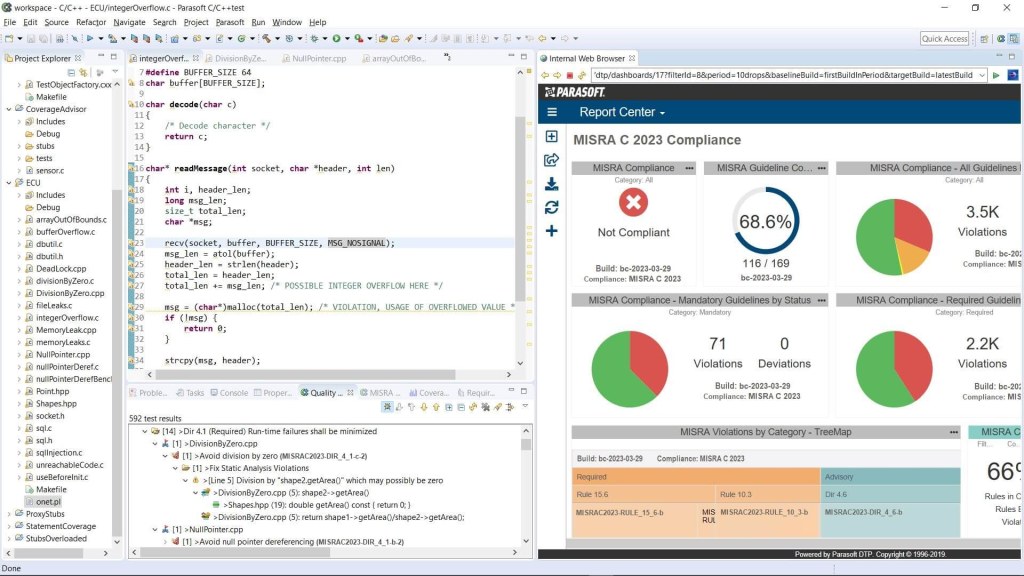Mastering Code Quality Techniques: Unlocking Software Excellence With Actionable Strategies!
Code Quality Techniques: Improving Software Development and Performance
Greetings, Readers! In the fast-paced world of software development, ensuring code quality is paramount for creating efficient and reliable applications. In this article, we will explore various techniques to enhance code quality, equipping you with the knowledge to write clean, maintainable, and high-performing code.
Introduction
Software development is an intricate process that involves writing lines of code to create functional applications and systems. Code quality refers to the overall excellence of the codebase, encompassing factors such as readability, maintainability, efficiency, and adherence to coding standards. By adopting code quality techniques, developers can significantly enhance the reliability, scalability, and performance of their software.
1 Picture Gallery: Mastering Code Quality Techniques: Unlocking Software Excellence With Actionable Strategies!

In this article, we will delve into the what, who, when, where, why, and how of code quality techniques, providing you with a comprehensive understanding of this critical aspect of software development.
What are Code Quality Techniques?
Code quality techniques encompass a range of practices aimed at improving the overall quality of the codebase. These techniques focus on enhancing readability, maintainability, performance, and scalability. By following these practices, developers can write code that is easier to understand, modify, and optimize.
Examples of code quality techniques include:

Image Source: parasoft.com
Code reviews: Regularly reviewing code with fellow developers to identify and address issues, bugs, and potential improvements. ✅
Test-driven development (TDD): Writing tests before writing the actual code, ensuring that the code meets the specified requirements. ✅
Automated testing: Implementing automated tests to verify the correctness and functionality of the codebase, reducing the chances of introducing bugs. ✅
Static code analysis: Utilizing tools to analyze the codebase and identify potential issues, such as complex code, unused variables, or memory leaks. ✅
Code refactoring: Restructuring and optimizing existing code to improve readability, performance, and maintainability. ✅
Coding standards: Following established coding standards and best practices to ensure consistency and readability across the codebase. ✅
Performance profiling: Analyzing the performance of the codebase to identify bottlenecks and optimize critical sections. ✅
By incorporating these techniques into the development process, software teams can produce higher-quality code, resulting in more robust and reliable applications.
Who Benefits from Code Quality Techniques?
Code quality techniques benefit various stakeholders involved in the software development process:
Developers: By following code quality practices, developers can write code that is easier to understand, work with, and maintain. This leads to improved productivity and job satisfaction. ✅
Quality Assurance (QA) teams: High-quality code reduces the time and effort required for testing, allowing QA teams to focus on critical scenarios and edge cases. ✅
Project Managers: Implementing code quality techniques improves the overall reliability and stability of the software, reducing the risk of project delays or failures. ✅
End-users: Well-written and optimized code results in applications that are more responsive, performant, and free from bugs, providing a seamless user experience. ✅
By prioritizing code quality, all stakeholders can benefit from improved development processes, reduced maintenance efforts, and higher customer satisfaction.
When Should Code Quality Techniques Be Used?
Code quality techniques should be incorporated throughout the entire software development lifecycle. From the initial planning and design phase to the final deployment and maintenance, emphasizing code quality ensures the longevity and stability of the software.
Early adoption of code quality techniques allows developers to lay a solid foundation, resulting in a more maintainable and extensible codebase. Regular code reviews, automated testing, and static code analysis should be performed during development to identify and address potential issues before they become critical.
Additionally, code quality techniques should be applied during code refactoring or optimization efforts. By improving the quality of existing code, developers can eliminate unnecessary complexity and enhance performance.
Where to Apply Code Quality Techniques?
Code quality techniques can be applied to projects of any size or complexity. Whether developing a simple web application or a complex enterprise system, investing in code quality ensures the long-term success and maintainability of the software.
These techniques are applicable across various programming languages and frameworks, allowing developers from different backgrounds to benefit from their implementation.
Why Are Code Quality Techniques Important?
Code quality techniques play a vital role in software development for several reasons:
Maintainability: High-quality code is easier to understand, modify, and maintain, reducing the time and effort required for future enhancements or bug fixes. ✅
Readability: Well-structured and well-documented code improves collaboration among developers and enhances the overall readability and understandability of the codebase. ✅
Scalability: Code quality practices ensure that the software can scale effectively, accommodating future requirements and minimizing performance bottlenecks. ✅
Reliability: High-quality code reduces the likelihood of bugs, crashes, and unexpected behavior, resulting in more reliable and stable applications. ✅
Efficiency: Optimized code improves the performance and responsiveness of the software, enhancing the user experience. ✅
By prioritizing code quality, developers can create software that is more maintainable, scalable, reliable, efficient, and ultimately successful.
How to Implement Code Quality Techniques?
Implementing code quality techniques requires a combination of technical skills, tooling, and a commitment to best practices. Here are some steps to get started:
Educate your team: Ensure that all team members understand the importance of code quality and are familiar with the relevant techniques and best practices. ✅
Establish coding standards: Define and enforce coding standards to ensure consistency and readability across the codebase. Utilize linters or static code analysis tools to automate adherence to these standards. ✅
Perform code reviews: Regularly review code within your team, providing feedback and identifying areas for improvement. ✅
Automate testing: Implement automated unit, integration, and regression tests to validate the correctness and functionality of your code. Utilize frameworks and tools to simplify test creation and execution. ✅
Utilize static code analysis tools: Integrate tools that analyze your codebase for potential issues, such as complexity, code duplication, or security vulnerabilities. Address the identified issues to improve code quality. ✅
Refactor and optimize: Continuously improve the codebase by refactoring and optimizing existing code. Eliminate unnecessary complexity, improve performance, and enhance maintainability. ✅
Monitor and measure: Regularly assess the performance and maintainability of your codebase. Utilize profiling tools to identify performance bottlenecks and address them accordingly. ✅
By implementing these techniques and continuously seeking opportunities for improvement, your team can enhance code quality and deliver robust, efficient, and high-performing software.
Advantages and Disadvantages of Code Quality Techniques
Code quality techniques offer numerous advantages and a few potential disadvantages:
Advantages:
Improved maintainability and readability of the codebase. ✅
Reduced risk of bugs, crashes, and unexpected behavior. ✅
Enhanced collaboration among developers. ✅
Better scalability and performance of the software. ✅
Increased productivity and job satisfaction for developers. ✅
Disadvantages:
Potential increase in development time due to additional processes, such as code reviews and testing. ✅
Learning curve for new team members not familiar with code quality techniques. ✅
While the advantages of code quality techniques far outweigh the potential disadvantages, it is essential to consider these factors when implementing them.
Frequently Asked Questions (FAQ)
Q: Are code quality techniques only applicable to large software projects?
A: No, code quality techniques are beneficial for projects of all sizes. Regardless of project complexity, code quality practices improve maintainability and reliability. ✅
Q: Can code quality techniques slow down the development process?
A: While code quality techniques introduce additional processes, such as code reviews and testing, the long-term benefits outweigh any potential initial slowdowns. The time invested in code quality pays off through improved productivity and reduced maintenance efforts. ✅
Q: Which code quality technique is the most important?
A: All code quality techniques play a crucial role in software development. The importance of each technique depends on the specific context, project requirements, and team dynamics. It is recommended to adopt a holistic approach and incorporate multiple techniques to achieve the best results. ✅
Q: How can code quality be measured objectively?
A: Code quality can be measured through various metrics, such as code coverage, code complexity, and the number of bugs. Additionally, feedback from code reviews, testing results, and the overall stability and performance of the software provide valuable insights into code quality. ✅
Q: Are code quality techniques universal across programming languages?
A: While the underlying principles of code quality techniques apply universally, the specific implementation may vary across programming languages and frameworks. It is essential to adapt and utilize tools and practices that are relevant to the chosen technology stack. ✅
Conclusion
In conclusion, prioritizing code quality techniques is essential for creating robust, maintainable, and high-performing software. By incorporating practices such as code reviews, automated testing, and code refactoring, developers can ensure the readability, reliability, and scalability of their codebase.
Remember, code quality is a continuous effort that should be embraced by the entire development team. By adhering to coding standards, utilizing static code analysis tools, and continuously seeking opportunities for improvement, you can elevate your software development process and deliver exceptional applications.
Final Remarks
Code quality techniques are not just buzzwords; they are fundamental to the success of any software development project. Whether you are a seasoned developer or just starting your journey, investing time and effort in mastering code quality techniques will undoubtedly yield tremendous benefits.
However, it is essential to note that code quality techniques are not a one-size-fits-all solution. Each project and team is unique, and it is crucial to adapt and tailor these techniques to suit your specific needs.
By embracing code quality techniques, you are not only improving your codebase but also empowering yourself and your team to build innovative and reliable software solutions that make a difference in the world of technology.
This post topic: Programming


